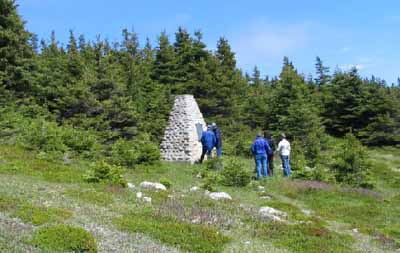Wolfe's Landing National Historic Site of Canada
Kennington Cove, Nova Scotia

General view
(© Parks Canada Agency / Agence Parcs Canada, David Henderson, 2005.)
Address :
Louisbourg Highway, Kennington Cove, Nova Scotia
Recognition Statute:
Historic Sites and Monuments Act (R.S.C., 1985, c. H-4)
Designation Date:
1929-05-17
Dates:
-
1758 to 1758
(Significant)
Event, Person, Organization:
-
Battle for the Fortress of Louisbourg
(Event)
-
Brigadier-General James Wolfe
(Person)
-
French Army
(Organization)
-
British Royal Navy
(Organization)
-
British Army
(Organization)
Other Name(s):
-
Wolfe's Landing
(Designation Name)
-
WOLFE'S LANDING
(Plaque name)
Research Report Number:
2006 SDC-016
DFRP Number:
03639 00
Description of Historic Place
Wolfe’s Landing National Historic Site of Canada is located in Kennington Cove, on the east coast of Cape Breton Island, Nova Scotia. Contained entirely within the Fortress of Louisbourg National Historic Site of Canada, the site is bounded by a rocky beach to the south, and a rolling landscape of grasses and forest to the north, east and west. It was from this site that, during the Seven Years’ War, British forces launched their successful attack on the French forces at Louisbourg. The site includes the cove with its two modern beaches, numerous trails, and the Historic Sites and Monuments Board of Canada cairn. Official recognition refers to the irregular 5-hectare polygon that encompasses the site.
Heritage Value
Wolfe’s Landing was designated a national historic site of Canada in 1929 because: here, on 8 June 1758, the men of Brigadier General James Wolfe’s brigade made their successful landing, leading to the capitulation of Louisbourg.
The battle at the French Fortress of Louisbourg was one of the definitive battles between Britain and France for dominance in North America. Two years into the Seven Years’ War, the British executed plans to lay siege to the fortress, located on Cape Breton Island. On June 8th, 1758, Brigadier General James Wolfe, under heavy fire from French troops, successfully landed a party of light infantry on an undefended rocky beach in Kennington Cove, known to the French as Anse de la Cormorandière. The successful landing allowed Wolfe and his troops to launch a surprise attack against the French. Unaware of the size of Wolfe’s force and fearing the worst, the French troops quickly retreated towards the Fortress of Louisbourg. While the landing of the entire British force took weeks to complete, the initial landing of Wolfe and his troops, and subsequent evacuation of the French forces from the various defense works, created the opportunity for the British to lay siege to Louisbourg. The French fortress capitulated near the end of July 1758, effectively ending the period of French rule in Cape Breton.
Sources: Historic Sites and Monuments Board of Canada, Minutes, May 1929, June 2006.
Character-Defining Elements
Key elements contributing to the heritage value of this site include: its location within the boundaries of the Fortress of Louisbourg National Historic Site of Canada; its setting along the rocky beaches at Kennington Cove; the rural character of the hilled, grassy landscape; the integrity of any surviving or as yet unidentified archaeological remains which may be found within the site in their original placement and extent; the viewscapes from the trees to the beaches and from the beaches out to the Atlantic Ocean; the relationship between the open ground and the beaches and the water beyond.